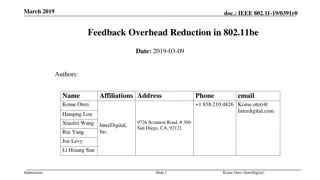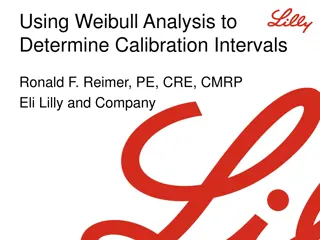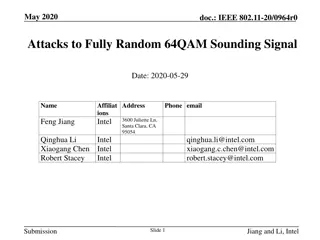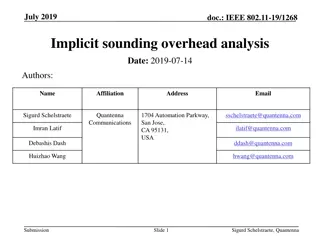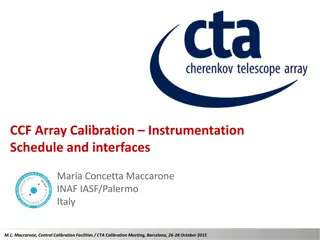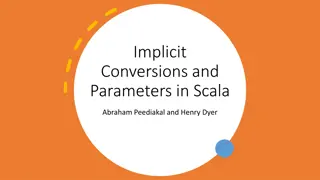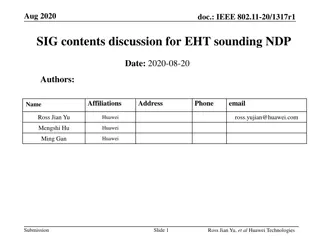Implicit Sounding Calibration in IEEE 802.11-19/1193r0
Proposal to consider implicit sounding in TGbe to reduce overhead for 16ss and multi-AP cases. The calibration accuracy is crucial to maintain channel reciprocity. Lab test results demonstrate the feasibility of implicit sounding. The document discusses absolute and relative calibration methods in 802.11n, emphasizing the importance of accurate calibration for effective transmission in wireless networks.
Download Presentation

Please find below an Image/Link to download the presentation.
The content on the website is provided AS IS for your information and personal use only. It may not be sold, licensed, or shared on other websites without obtaining consent from the author.If you encounter any issues during the download, it is possible that the publisher has removed the file from their server.
You are allowed to download the files provided on this website for personal or commercial use, subject to the condition that they are used lawfully. All files are the property of their respective owners.
The content on the website is provided AS IS for your information and personal use only. It may not be sold, licensed, or shared on other websites without obtaining consent from the author.
E N D
Presentation Transcript
November 2019 doc.: IEEE 802.11-19/1193r0 Calibration of Implicit Sounding Date: 2019-11 Authors: Name Affiliations Address email Yunping (Lily) Lv Nanjing, China lvyunping@huawei.com Bo (Boyce) Yang Nanjing, China Huawei Nanjing, China Fangchao (Dylan) Yuan Submission Slide 1 Lily Lv, Huawei, et al.
November 2019 doc.: IEEE 802.11-19/1193r0 Abstract [1][2][3][4] propose to consider implicit sounding in TGbe, in order to reduce overhead for 16ss and multi AP cases. On the other hand, implicit sounding needs accurate calibration to maintain channel reciprocity, although the procedure of calibration does not need to be part of the standard. In this contribution, we show our lab test results on calibration accuracy, proving the feasibility of implicit sounding. Submission Slide 2 Lily Lv, Huawei, et al.
November 2019 doc.: IEEE 802.11-19/1193r0 Recap of calibration 802.11n calibration Calibration in 802.11n is an absolute calibration , involving both AP and STAs. After calibration procedure, the correction matric KA/KB can be computed which is used to restore baseband-to-baseband channel reciprocity. Submission Slide 3 Lily Lv, Huawei, et al.
November 2019 doc.: IEEE 802.11-19/1193r0 Recap of calibration Relative calibration [1] Different from absolute calibration, relative calibration only involves AP side. Each antenna is calibrated with a reference antenna, getting a relative factor C Use relative factor C to compensate steering matrix for MIMO/BF. im mi 1 2 Submission Lily Lv, Huawei, et al.
November 2019 doc.: IEEE 802.11-19/1193r0 Relative Calibration Accuracy Test Step 1 Test set up: Calculate relative calibration factor C Master AP Master AP and slave AP are connected to a coordinator(server) via wired link Procedure: Master AP send NDP to slave AP from its 2 antennas simultaneously slave AP send NDP to master AP from one of its antennas Calculate relative calibration factor C for master AP according to the following formula Slave AP ? = 1,?2 ?? ?1 ??,?2 = ?? ?2 ?? ,? ??? ?1= ?1 ?2 ?1 NDP M2S Master AP NDP S2M Slave AP Submission Slide 5 Lily Lv, Huawei, et al.
November 2019 doc.: IEEE 802.11-19/1193r0 Relative Calibration Accuracy Test Step 1 Calculate relative factor C Test result 1: 10 times measurement ??,?2 ??,?2 ?? Blue: ???= ?1 Green: ???= ?1 Red: ? = ?1,?2 = ?? ??? ??? Observation: The calibration factor does not change much for measurements at different times Additional HE-LTF can further improve calibration accuracy Submission Slide 6 Lily Lv, Huawei, et al.
November 2019 doc.: IEEE 802.11-19/1193r0 Relative Calibration Accuracy Test Comparison of explicit sounding and implicit sounding Test set up: Master AP has 2 antennas, STA has one antenna Using calibration factor achieved from step 1 Procedure: Master AP send NDP to STA from its 2 antennas simultaneously(explicit sounding, Ng=1) STA estimate downlink channel ???. STA send NDP to master AP (implicit sounding) Master AP estimates uplink channel ???. Calculate the downlink channel from uplink channel Step 2 Master AP STA ??? = ??? ? Explicit Sounding NDP Master AP Implicit Sounding NDP STA Submission Slide 7 Lily Lv, Huawei, et al.
November 2019 doc.: IEEE 802.11-19/1193r0 Relative Calibration Accuracy Test Step 2 Test result Compare explicit sounding channel with implicit sounding channel ??? ? ??? ??? EVM = 20log Observation: Additional error of implicit sounding with Channel calibration is about -37dB@50% if no repeated HE-LTF. Additional HE-LTF could further improve the performance. Submission Slide 8 Lily Lv, Huawei, et al.
November 2019 doc.: IEEE 802.11-19/1193r0 Data Transmission with Implicit Sounding Calibration Sounding MU/JT Transmission Cali NDP Data Transmission Master AP Cali NDP NDP Trigger Data Transmission Slave AP Sounding NDP STA Three stages are involved. Almost no additional complexity to STAs: Calibration: involving AP only, could be left to implementation Sounding: existing trigger mechanism, with additional feedback type (Sounding NDP) Data transmission no changes Meanwhile, implicit Sounding NDP is transmitted by non-AP STA, which is transparent to the antenna numbers of AP or distributed APs. Submission Slide 9 Lily Lv, Huawei, et al.
November 2019 doc.: IEEE 802.11-19/1193r0 Conclusion Relative calibration involves AP only, adding no complexity to the STAs. Test results show that implicit sounding with relative calibration can estimate the channel status very accurately. Introducing Implicit sounding almost add no complexity to STAs. Submission Slide 10 Lily Lv, Huawei, et al.
November 2019 doc.: IEEE 802.11-19/1193r0 References [1] 19/767 Implicit Channel Sounding in IEEE 802.11 (Feasibility Study) [2] 19/768 Implicit Channel Sounding in IEEE 802.11 [3] 19/1268 Implicit sounding overhead analysis [4] 18/1191 MU sounding improvements Submission Slide 11 Lily Lv, Huawei, et al.






